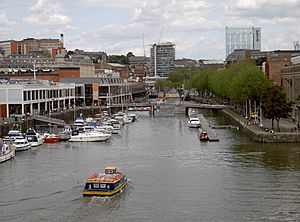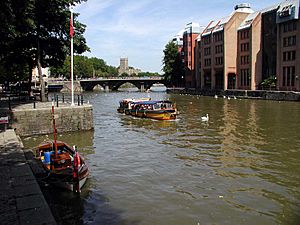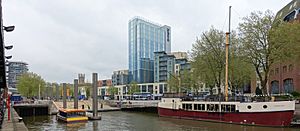Bristol Ferry Boats facts for kids
Bristol Ferry Boats are like water buses that travel around Bristol Harbour in the city of Bristol, England. You can easily spot them because they are painted bright yellow and blue!
These boats used to belong to the Bristol Ferry Boat Company. But now, they are run by a special group called Bristol Community Ferry Boats. This is a community interest company, which means it's a business that works for the good of the community, not just to make money for a few owners.
Bristol Ferry Boats offer regular trips, like a bus service on the water. They also do fun boat tours for learning or just for sightseeing. You can even rent a boat for a private event! Their regular trips connect Bristol city centre to Temple Meads railway station and Hotwells. They stop at 17 different places along the harbour, including a stop near Brunel's famous ship, the SS Great Britain. These services operate on their own, without money from the government, and they compete with other boat services.
History of Bristol Ferry Boats
The idea for Bristol Ferry Boats started in 1977. A group in Bristol called City Docks Ventures, which worked to protect the city's harbour, bought the first ferry boat, Margaret. Ian Bungard was the first skipper (boat captain).
In 1978, Ian Bungard bought Margaret and began to grow the business. Another boat, Independence, joined Margaret in 1980. The ferry service offered trips all year round for fun, sightseeing, and even for people going to work. It showed how Bristol's Floating Harbour was changing from a place for cargo ships to a fun area for everyone.
The yellow and blue boats became very well known. In 1984, Royal Mail even put a picture of Margaret on a special stamp!
In 1992, the company got Emily, their first boat with an enclosed (covered) area. Then, in 1997, Matilda joined the fleet. Matilda was the first boat built especially for Bristol Ferry Boats.
In 2002, Ian Bungard sold the business to Rob and Jane Salvidge. For a while, the company ran extra services to Hotwells and Temple Meads. These services received money from Bristol City Council to help them run. In 2004, a short ferry service across the harbour was added.
However, in 2007, another company took over the contract for these special services. Bristol Ferry Boats continued to run their main services without government help.
In November 2012, the Bristol Ferry Boat Company faced financial difficulties. Supporters, including the original owner Ian Bungard, bought the boats back. In 2013, a big effort began to turn the company into a community-owned business. Many people from Bristol invested, and now Bristol Community Ferry Boats Limited is owned by its 871 shareholders.
Where the Ferries Go
Bristol Ferry Boats run almost every day of the year, 364 days! They have one main route that connects Temple Meads railway station and Hotwells, passing through Bristol city centre. Boats leave every 40 minutes.
Here are the places the ferries stop:
| # | Landing stage | For |
|---|---|---|
| 1 | City Centre | The Centre, Watershed Arts Centre, Bristol Cathedral, College Green and City Hall |
| 2 | Cannons Marsh | Millennium Square and At-Bristol |
| 3 | Harbour Inlet | |
| 4 | Mardyke | |
| 5 | Hotwells-Pumphouse | Hotwells and Clifton Suspension Bridge (about a 20-minute uphill walk) |
| 6 | Hotwells-The Nova Scotia | Cumberland Basin and Underfall Yard |
| 7 | Hotwells-The Cottage | |
| 8 | Marina | Bristol Marina |
| 9 | Great Britain | The famous preserved Brunel steamship Great Britain |
| 10 | Wapping Wharf | |
| 11 | Prince Street Bridge | Arnolfini Art Gallery, Queen Square, M Shed and Bristol Harbour Railway |
| 12 | Bathurst Basin | Bathurst Basin |
| 13 | Welsh Back | Welsh Back, Bristol Bridge, Llandoger Trow and St Nicholas Market |
| 14 | Redcliffe Back | |
| 15 | Castle Park | Castle Park and Broadmead shopping district (with Cabot Circus and Galleries malls) |
| 16 | Temple Bridge | Cheese Lane Shot Tower |
| 17 | Temple Quay | Bristol Temple Meads railway station |
The Ferry Boat Fleet
The Bristol Ferry Boats have several different vessels (boats) in their fleet:
| Name | Built | Acquired | Passenger Capacity | Notes | Image |
|---|---|---|---|---|---|
| Brigantia | 2006 | 2006 | 50 | This boat has a steel hull and an enclosed area. It was built especially for Bristol Ferry, similar to Matilda. It has a wheelhouse that can be lowered and a wheelchair lift. | 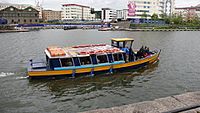 |
| Emily | 1927 | 1992 | 48 | Emily has a wooden hull and an enclosed area. It was built in Bideford and used to operate in Scarborough and Gloucester Docks. |  |
| Independence | 1927 | 1980 | 46 | This boat has a wooden hull and an open area. It was previously used on the Severn and Wye, and on the Erewash Canal. | 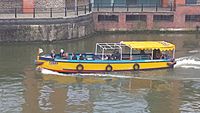 |
| Juno | 1990 | 2024 | 48 | Juno has a wooden hull with a canopy over the back and an open front. It was built in 1990 for use in Whitby. It was given to Bristol Ferry Boats in 2024 and was made ready for service in 2025. It can travel between Pulteney Weir and Cumberland Basin. |  |
| Margaret | 1952 | 1977 | 28 | Margaret has a wooden hull and an open area. It was built in Appledore and first used in Lynmouth. Later, it was a ferry across the Avon. |  |
| Matilda | 1997 | 1997 | 50 | Matilda has a steel hull and an enclosed area. It is about 14 meters (46 feet) long and 4.6 meters (15 feet) wide. It was built specifically for Bristol Ferry. | 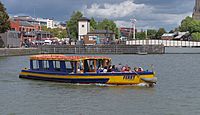 |
The boats Matilda and Brigantia are special because they can travel on the tidal Avon. This means they can go downstream from Bristol through the Avon Gorge all the way to Avonmouth. They can also travel throughout Bristol Harbour and upstream on the Avon to the city of Bath. The other boats are only allowed to operate within Bristol Harbour and the upstream Avon.


